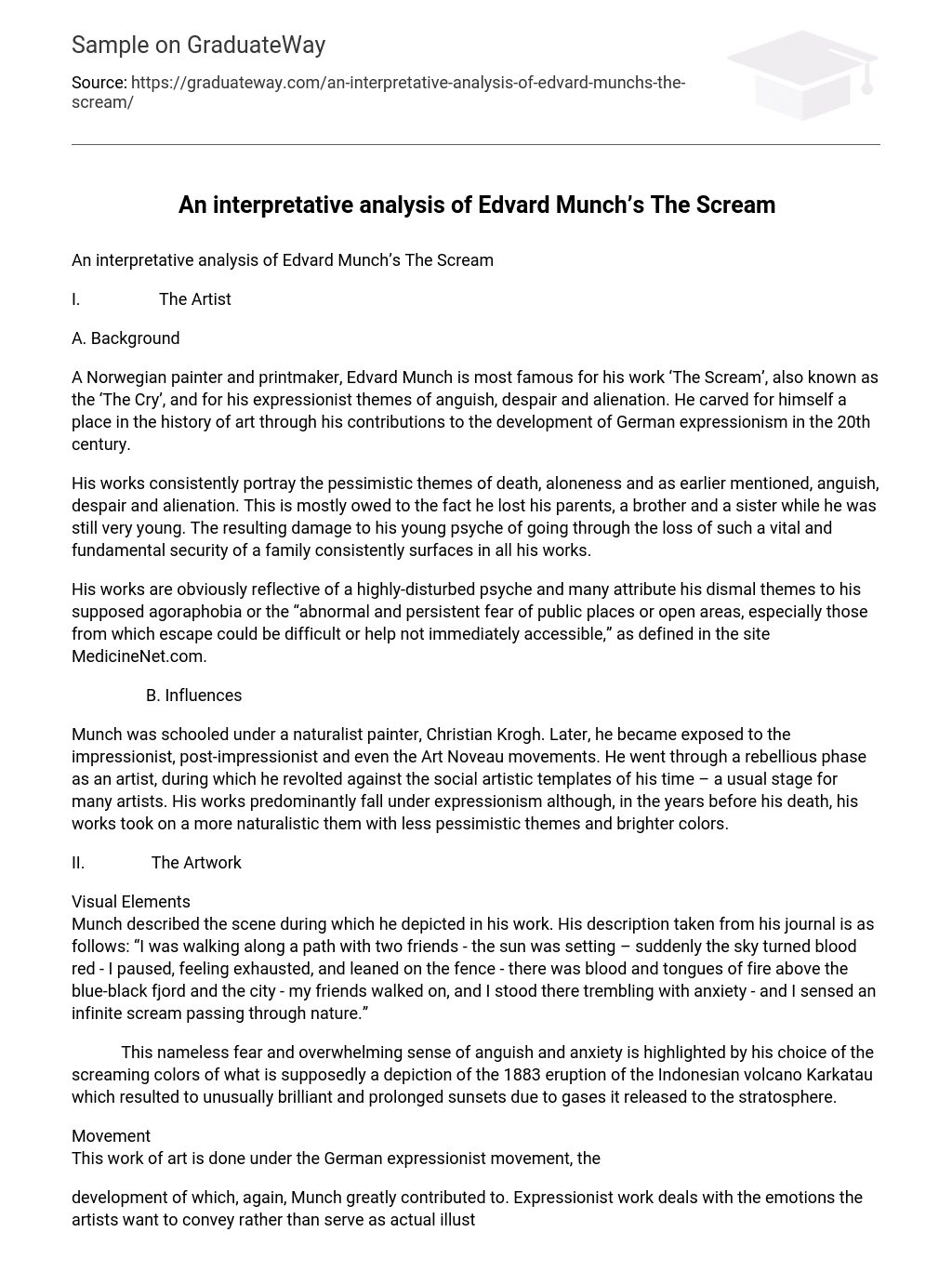The Artist
Background
A Norwegian painter and printmaker, Edvard Munch is most famous for his work ‘The Scream’, also known as the ‘The Cry’, and for his expressionist themes of anguish, despair and alienation. He carved for himself a place in the history of art through his contributions to the development of German expressionism in the 20th century.
His works consistently portray the pessimistic themes of death, aloneness and as earlier mentioned, anguish, despair and alienation. This is mostly owed to the fact he lost his parents, a brother and a sister while he was still very young. The resulting damage to his young psyche of going through the loss of such a vital and fundamental security of a family consistently surfaces in all his works.
His works are obviously reflective of a highly-disturbed psyche and many attribute his dismal themes to his supposed agoraphobia or the “abnormal and persistent fear of public places or open areas, especially those from which escape could be difficult or help not immediately accessible,” as defined in the site MedicineNet.com.
Influences
Munch was schooled under a naturalist painter, Christian Krogh. Later, he became exposed to the impressionist, post-impressionist and even the Art Noveau movements. He went through a rebellious phase as an artist, during which he revolted against the social artistic templates of his time – a usual stage for many artists. His works predominantly fall under expressionism although, in the years before his death, his works took on a more naturalistic them with less pessimistic themes and brighter colors.
The Artwork
Visual Elements
Munch described the scene during which he depicted in his work. His description taken from his journal is as follows: “I was walking along a path with two friends – the sun was setting – suddenly the sky turned blood red – I paused, feeling exhausted, and leaned on the fence – there was blood and tongues of fire above the blue-black fjord and the city – my friends walked on, and I stood there trembling with anxiety – and I sensed an infinite scream passing through nature.”
This nameless fear and overwhelming sense of anguish and anxiety is highlighted by his choice of the screaming colors of what is supposedly a depiction of the 1883 eruption of the Indonesian volcano Karkatau which resulted to unusually brilliant and prolonged sunsets due to gases it released to the stratosphere.
Movement
This work of art is done under the German expressionist movement, the development of which, again, Munch greatly contributed to. Expressionist work deals with the emotions the artists want to convey rather than serve as actual illustrated depictions of reality. Expressionist artists embed in their work deep emotional experiences and subjects are often repeatedly altered into convoluted forms which result to intense and rather concentrated art form.
Expressionism differs from Impressionism in that latter aims to portray impressions that the environment or the surroundings evoke whereas, Expressionism projects the artist’s own sensibility and his/her understanding of the world, and allows for distortions and even exaggerations in the process of depiction. For “The Scream”, the name does not necessarily refer to an actual scream but rather to the sense of listlessness to participate in life: a nameless, pervasive sense of detachment which Munch obviously suffered from.
Theme
Basically, the strongest appeal of Munch’s most familiar work – which has actually gained iconic status (i.e. Macualay Culkin’s famous pose in the movie series, “Home Alone”) – is its strong and very accurate depiction of the universal human experience of being lost, stripped off one’s securities and completely removed from one’s comfort zone.
Existential anguish is something is repeatedly illustrated in many of Munch’s works but never was the concept as strikingly described as it is in “The Scream”. Given the numerous deaths in his family and having had to go through the ordeal of a mentally disturbed sister who was later on consigned to an asylum, Munch was plagued with haunting sense of existential anguish.
According to Jean Paul Sartre, existentialism is “a form of pessimism (a philosophy of despair), preoccupied with the dark and negative aspects of human existence.” ‘The Scream’, being an icon for the philosophical movement, illustrates this form of “desperate quietism” in the soundless and desperate scream of a man, clutching his head, standing in the middle of a bridge, seemingly unseen and/or ignored by the world and evoking strong images of fear, despair and anguish through the colors of an unusually brilliant sunset in the background.
List of references
- Pioch, Nicolas. Expressionism. US: Web Museum, 2006
- Sartre, J.P. Existentialism is a Humnism. (Translated by Carol Macomber). USA: Yale University Press, 2007
- Prideaux, S. Edvard Munch: Behind the Scream. USA: Amazon Books, 2007





